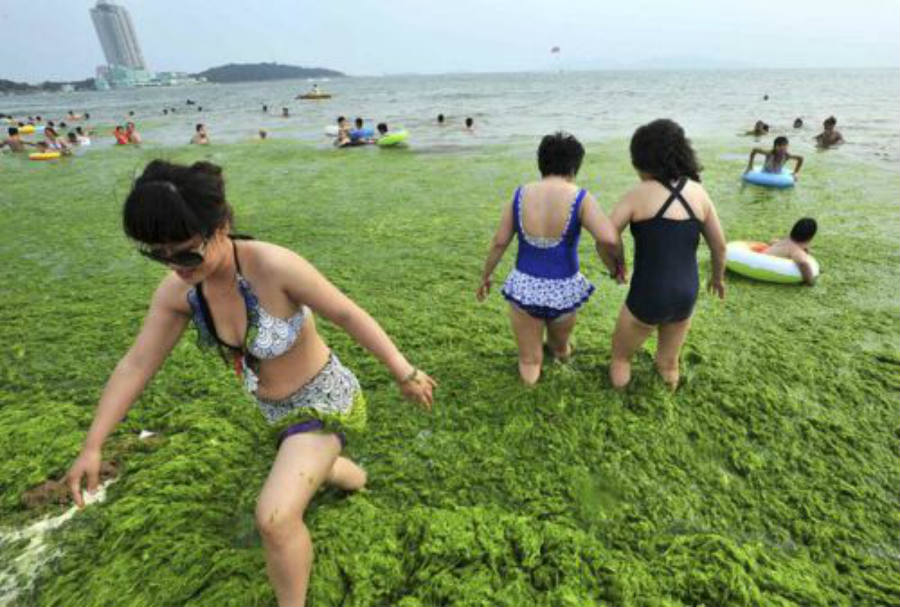Summer is coming, and the danger of blue-green algae increases in Minnesota. Health authorities warn about the toxicity of this natural phenomenon in humans and pets.
The reproduction of blue-green algae is prone to occur in warm temperatures. The growth of these microscopic organisms bases its causes also during long periods of sunlight exposure, resulting in the proliferation of blue-green algae in lakes, ponds, rivers and streams. The quick reproduction of these organisms is known as bloom, and it can be detected by the change of color of the water, it gets green, and by the scams presented on the water’s surface. However, it is not just a natural phenomenon that can be perceived by human eye during summer. Some species in algal blooms can produce toxins; this is why these flowers may represent a risk for people and animals.

Since the start of the summer is round the corner, the Minnesota Department of Health (MDH) warns citizens to take cautions in the presence of blue-green algae bloom in Minnesota’s waters. A Minnesota’s epidemiologist, Stephanie Gretsch, has said that summer is the season when algal blooms are expected, in fact, the worst blooms occur during this time of the year. According to her, this year mild spring and warm days have been registered in May. Therefore, blue-green algae blooms have been spotted on Minnesota lakes.
Last year, The Minnesota Pollution Control Agency (MPCA) and Minnesota Department of Health (MDH) investigated two cases of human illness and several dogs deaths linked to the presence of blue-green algal blooms all spread across lakes in the state.
Even if most of the blue-green algae blooms are not detrimental, the toxins released by them can be harmful to health. Blooms could have adverse effects on health when the toxins presented in scums or water get in touch with humans or animals. The algal toxins can be swallowed, inhaled or when they make contact with skin. According to Minnesota’s health authorities, people can get sick after swimming, boating, bathing, or practicing any other activity in waters containing toxic blue-green algae.
Harmful #algal blooms can have significant #economic, environmental & health impacts https://t.co/YfYGDuVooO pic.twitter.com/QpgMtZPMIr
— EU_ScienceHub (@EU_ScienceHub) May 25, 2016
Adverse effect of the toxic bloom
The contact with toxic bloom can lead to skin irritation ( the most common symptom ) but also it can cause vomiting, diarrhea, nausea, throat irritation, allergic reactions, headache, among others. Depending on the quantities ingested, the toxicity of algal bloom may also affect the liver and nervous system.
Children are more vulnerable than adults because of their low body weight. Also, they usually have sensitive skin, which leads to a quick appearance of the rash, and considering their constant engagement in water activities, they are more likely to swallow or inhale toxic waters from blooms.
Dogs, as well as children, are more apt to be exposed to the toxicity of blue-green algal bloom. When human realizes areas full of scums, they immediately avoid them, but dogs walk in those infected surfaces and they even swim for fun or to cool down during warm days, thus, they are prone to swallow big amounts of toxic waters.

In fact, the Minnesota Department of Health confirmed that two dogs died in 2014 and three more in 2015, as a consequence of swallowing water from harmful blooms.
According to Gretsch, the levels of toxicity of blooms are so high that animals can quickly become sick, it is not just a matter of the animal’s weak immune system or if they are old because even healthy animals could present serious health problems after being exposed to toxins of this type.
Alexis Donath, the public information officer for the Minnesota Health Department, has said that due to climate change, algal blooms may become more dense and frequent in future.
Minnesota’s health authorities exhort people to stay away from waters with an unpleasant or glassy smell or if they present scums on the surface or along shorelines.
In the case of contact with an algal bloom, wash immediately with fresh water and soap. Pets also must be washed away if thought they swam in a blue-green algae lake. Both: people and animals must look for medical assistance if the case of presenting any of the symptoms named above.
Dogs as sentinels: Blue-green algae brings toxic mystery to Minn. waters #toxicalgae https://t.co/YjlHeUL8W0
— Toxic Algae News (@toxicalgaenews) May 25, 2016
Avoiding algal blooms toxicity
Even if during summer, lakes become popular in Minnesota and the rest of the country, health risks linked to this phenomenon have been proved in humans and animals. Health authorities strongly advise citizens to wait for cooler temperatures. Winds and rains disperse algal blooms.
Contact with blue-green colored water should be avoided at all. Sometimes, lakes do not have big flowers but small portions of it, even though, algal blooms toxicity can reach to those areas that look like clean. So, any activity (swimming, bathing, wading, boating, etc.) in waters containing algal blooms should be limited. Considering that children and dogs are particularly at risk, adults have to check carefully out if the lake has any trace of former or current blooms.
Source: Health State
